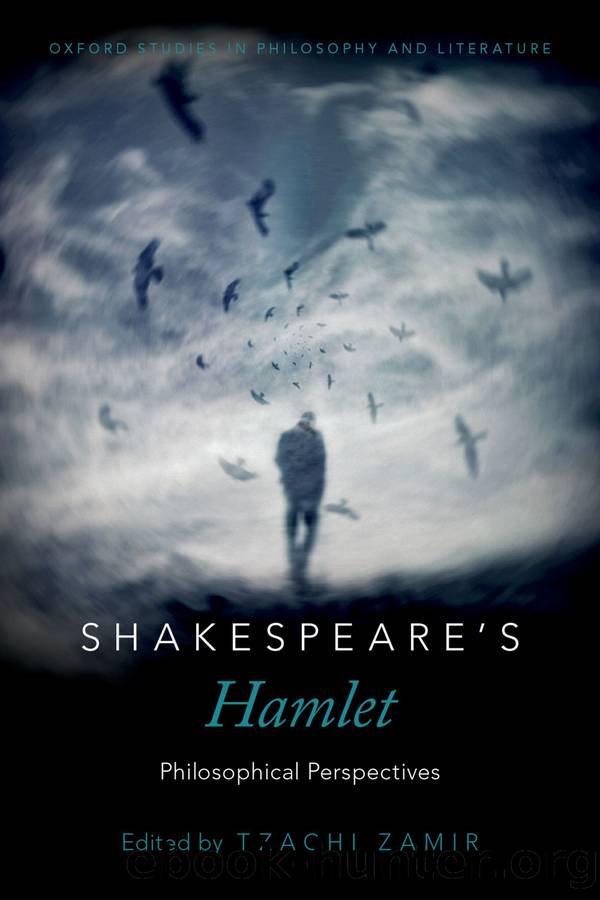Shakespeare's Hamlet by Tzachi Zamir;

Author:Tzachi Zamir;
Language: eng
Format: epub
Publisher: OUP Premium
Published: 2017-12-15T00:00:00+00:00
HAMLETâS CHIASMUS OF THEATRICALIZATION
The key to seeing the extent and significance of chiasmus in Hamletâs language is to recognize that he finds himself, throughout, in an agonizing condition of cross-purposes that takes chiastic form. Shakespeare shows how a chiasmus of theatricalization lies in wait within the human imagination itself and how, by facing its challenges, that chiasmus can be harnessed to produce consciousness of an inner atemporality where inward being is disclosed. By the imaginationâs inherent theatricalization I mean the back-and-forth movements between role-playing consciousness and a would-be non-role-playing consciousness that is never free from role playing. Hamletâs meditative employmentâhis productive thinkingâof chiasmus, right to left and left to right, AB:BA, ad infinitum, is his mirror held up to nature. The elements of chiasmus necessarily form an effectively infinite progression because, as Lisa Freinkel has nicely put it, âRepetition becomes inversion and inversion takes us back to where we started,â so that chiasmus initiates âan exchange that seems to have no beginning and no end.â12 Hamletâs representations, to himself, of his chiastic condition constitute repeated attempts to grasp the totality of infinite progressions, and they repeatedly produce momentary inhibitions or suspensions of consciousness of the immediate external world. In other words, in Hamletâs hands chiasmus becomes a compact, portable engine of infinite progression and of experiencing the impossibility of grasping the totality of such a progression. Judging by the intensity of his recurring to chiasmus we may well conclude that he knows, or at least senses, the blessings it can confer. He knows or senses that the failure it entails can somehow leave him with the residual consciousness of a self in an inward now. He knows, or senses as well, that paradoxically, the use of this instrument of momentary suspension can ultimately furnish the grounds for his experience and action in the world. Indeed, one of the abiding, creative paradoxes of Hamletâs thinking (and his grasp of hisâof humanityâsâcondition) is centered in the back-and-forth movements of his theatrical chiasmata: these repeatedly disclose a resolute purposiveness within apparent vacillation. This paradox reaches a climax in his âIf it be . . .â clauses concerning the now, in act 5. I will yet return to these clauses, but I note already that they, too, are tightly driven by the effects of chiasmus: âIf it [A] be now, âtis [B] not to come. If it be [B] not to come, it will [A] be nowâ (5.2.198â99).13
Hamletâs most significant use of the chiasmus of theatricalizationâserving virtually as a template for all his other employments of this figureâis his self-accusatory question concerning the playerâs capacity to feel and to express emotion. After asking about that emotion, âall for nothingâFor Hecuba?â he asks further:
Whatâs [A] Hecuba to [B] him, or [B] he to [A] her,
That he should weep for her?
(2.2.494â95).
Horatio says more than he knows when he describes the language of Hamletâs retreat into theatrical disguise as âwhirling wordsâ (1.2.132). These chiastic whirling words consist of a layering of play-acting upon would-be non-play-acting upon play-acting, ad infinitum.
Download
This site does not store any files on its server. We only index and link to content provided by other sites. Please contact the content providers to delete copyright contents if any and email us, we'll remove relevant links or contents immediately.
The Power of Myth by Joseph Campbell & Bill Moyers(1006)
Half Moon Bay by Jonathan Kellerman & Jesse Kellerman(953)
A Social History of the Media by Peter Burke & Peter Burke(936)
Inseparable by Emma Donoghue(927)
The Nets of Modernism: Henry James, Virginia Woolf, James Joyce, and Sigmund Freud by Maud Ellmann(834)
The Spike by Mark Humphries;(765)
The Complete Correspondence 1928-1940 by Theodor W. Adorno & Walter Benjamin(746)
A Theory of Narrative Drawing by Simon Grennan(742)
Culture by Terry Eagleton(718)
Ideology by Eagleton Terry;(696)
Bodies from the Library 3 by Tony Medawar(681)
World Philology by(675)
Farnsworth's Classical English Rhetoric by Ward Farnsworth(673)
Game of Thrones and Philosophy by William Irwin(669)
High Albania by M. Edith Durham(657)
Adam Smith by Jonathan Conlin(648)
A Reader’s Companion to J. D. Salinger’s The Catcher in the Rye by Peter Beidler(646)
Comic Genius: Portraits of Funny People by(616)
Monkey King by Wu Cheng'en(609)
